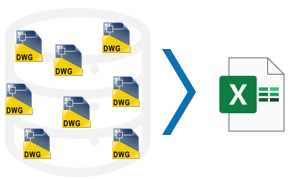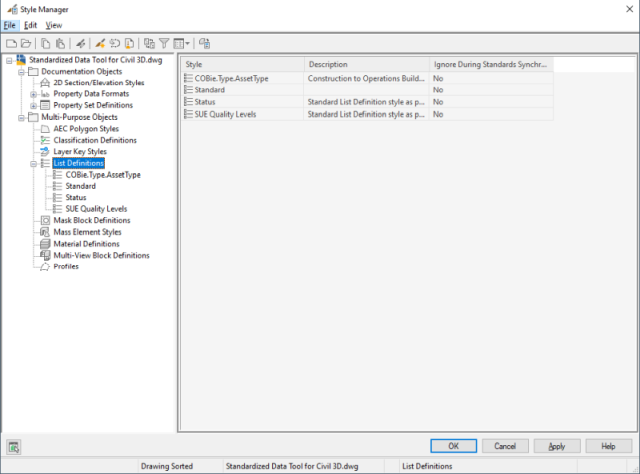Terminology
To help project teams manage the vast swaths of model data spread across multiple Civil 3D drawings, SDT has a system for file and project organization. To manage civil infrastructure models, concepts such as Collections and Jobs are applied to an existing project directory structure.
Like Data Shortcuts, SDT has some new nomenclature to introduce to Civil 3D users. And similar to Data Shortcuts it will be up to each project team to determine what breakdown of project files and project data will be the most beneficial and successful.
Overall, a group of related files will be designated in a Collection (think client, organization, airport, etc.). A Collection allows SDT to have visibility on all Jobs and their model files. To help organize this content, the Collection can be broken down into Job-specific files and data. Creating a Job is mandatory to add any Project Model File to a job through SDT, and this pool of model files is vital in the organization and reporting of project data. A Job must be stored in a Collection. If storing Jobs in a Collection is not desired, the SDT will utilize a default collection to store Jobs. Collections are critical in how SDT locates where the Jobs are stored.
Table of Contents
Collections
Every drawing (DWG) file is a database. To help organize this immense data structure, a hierarchy is required and must be established. Collections are used to organize and determine which Model Files and Jobs are required for the session. Like a Working Folder, a Collection will identify multiple design or project files and associate those files with a specific Job.
The goal of a Collection is to group like projects with differing templates and data requirements. The Standardized Data Tool was developed and designed with large infrastructure organizations in mind. For a smaller firm or organization, a single collection or the default Collection could be utilized for all active projects at the firm.
Jobs
Each project team uniquely organizes model files (DWG) pertaining to specific areas, phases, disciplines, or projects. The Job will be used to organize and collect these likewise model drawings. Jobs must be a member of an overall Collection and will utilize a specific directory location for all standards files that are utilized on the project.
For additional context: we have deliberately not used the term “Project”. There are many reasons for this, but primarily there are many existing uses of the term “Project” in the AutoCAD- or Civil 3D-world, and we wanted to avoid any confusion.
SDT wants to ensure granularity across project teams. Organization through Collections and Jobs aims to allow teams to leverage their own project files and folder structure while maintaining granularity in the data analysis capabilities. Separating model files into specific Jobs helps teams meet this goal. A unique identifier – or GUID – is associated with the Job and the associated Collection. This identifier is stored within each project model file’s AutoCAD DWGPROPS, in the Microsoft Windows file custom properties, and that Job Model File’s data is linked uniquely to that Job and Collection. Reviewing this identifier can be a useful troubleshooting step to check that Job and Collection assignments are functioning as expected.
A Job Model File may only be a member of a single Job and Collection. A Job provides the final level of granularity and organization when working in SDT. Data compiled in the Job Data File pertains to a single Job and the associated Job Model Files (drawings).
Jobs Standards Files
The Job Standards File – or JSF – is the heart of the customization of the extended data for the project and makes SDT function across an entire job. This file will dictate and manage all Property Set Definitions for the Job. Although this drawing file does not contain any project model information, it will include all customizations, properties, formats, and other related data management tools for that project. The JSF can be of one of the following file types: Drawing File (DWG), Template File (DWT), Drawing Standard File (DWS); DWTs and DWSs are technically at the core still DWG files, however, to distinguish these from DWGs, the alternate extension is provided and SDT supports these. SDT ships with three Job Standards Files in each of the mentioned formats, though each are the exact same Property Sets. When a new Job is created with SDT, the chosen JSF will be copied to the same location the Job file is stored to allow for unique JSF files per Job, providing the initial Property Definition information for syncing to the Job model files.
Property Set Definitions power the SDT tool and it supports both AutoCAD entities and Civil 3D objects including alignments, COGO points, feature lines, pressure pipes, and TIN surfaces. SDT contains over 36 property set definitions with almost 500 individual properties. A Job Standards File could (and should) be customized to meet the needs of each unique client or deliverable to ensure that project data across all civil information models are established early in the project development and adhered to throughout the lifecycle of the project. At any time during a project, if additional Property Set Definitions are needed in the Job’s Model Files, one may open the Job’s JSF file, add or remove the necessary Property Sets, and then use SDT’s Sync Standards or Batch Sync Standards tool to update the Job’s Model File’s Property Sets.
Job Model Files
Only Autodesk AutoCAD and Autodesk Civil 3D drawing files are supported by SDT.
SDT supports the attachment, management, and validation of model data to AutoCAD entities and many Civil 3D objects, as well as synchronization with Microsoft Excel.
Job Model Files – or JMF – are the individual Civil 3D or AutoCAD drawing files that make up a job. These are the files that contain both the Civil 3D objects and the AutoCAD entities that make up the project design. These are the individual drawing files that are used for the extraction of information, and the enumeration of individual asset data for each of the objects/entities with attached Property Set information.
In short, these JMFs are your standard AutoCAD or Civil 3D files that make up the civil information model.
There are additional JSFs and JDFs available on the Autodesk Interoperability website
Job Data Files
The Job Data File – or JDF – is the repository of all your Job’s Property Set data from the selected JMF’s objects/entities with Property Set information; it is the connection from the civil information model to the data spreadsheet. The Job Data File is a Microsoft Excel file, and an initial template is included with SDT.
When SDT’s Sync or Batch Sync tools are executed, sheet tabs with names corresponding to the Property Set name are created in the JDF automatically. The heading cells on a given tab correspond to the names of the Property Set Definitions within a Property Set. The objects/entities with these attached Property Sets are then logged in each row under the corresponding tab name, with it’s value in the corresponding Property Set Definition column. These tabs also contain some critical columns that are hidden by default such as the Job Model File path it belongs to and the AutoCAD Handle of the entity. These are critical when performing a sync from the JDF to the JMF objects/entities.
Most Property Set Definitions are editable within the JDF, however any cell that has a dark gray background should not be edited. These are critical data cells used by the SDT operations, or they are Property Set Definitions that can only be synced in one direction; from Civil 3D to the JDF. An example of one of these would be a Property Set Definition containing a Formula, which is in SDT terms, synced as a Sister Property. Formulas are evaluated by Civil 3D as the objects are updated, and therefore cannot be written back from the JDF to Civil 3D.
Custom properties that are added by the user to the JSF are typically editable in Microsoft Excel.
A JDF will be added for every job that is created and users may create their own customized spreadsheet templates to include such things as additional tabs/worksheets with picklists of data.
Property Sets
Autodesk drawing files are equipped to provide the user with a trove of model information. The surface level data could include a property such as color, layer, linetype, or style, but dig a bit deeper and every feature within that database could be an insightful goldmine of project information. SDT takes advantage of existing object data and, in turn, allows users to generate, populate, concatenate, and validate their own data. SDT uses the Style Manager to manage Property Set Definitions and allow for customization natively in-software.
The Style Manager is a toolset utility included in many Autodesk AutoCAD verticals (including Civil 3D) that provides a central location where the user can view, manage, and customize software specific styles. The left pane of the Style Manager displays the styles in all open drawings and templates in a hierarchical tree view that you can navigate by expanding and collapsing the different levels in the tree. By default, Property Set styles in the tree view are sorted by the drawing that contains them, but you can also sort them by style type. The tree view is always displayed in the left pane, regardless of how you sort the Property Set styles. The style information displayed in the right pane depends on what you select in the tree view in the left pane.
Generally, a style is applied to an object through the tool you use to create the object. However, SDT integrates the Attach Object Data and Batch Attach Object Data commands to help expedite the process of attaching styles to corresponding object types, versus natively in Civil 3D having to do one by one.

Sister Properties
The use of Sister Properties within the Standardized Data Tool for Civil 3D can be a bit confusing as to it’s need.
Property Sets Definitions that contain formulas require an SDT Sister Property in order for the properties to synchronize to the Job Data File when executing in batch. Natively in Civil 3D, as objects/entities are attached with Property Sets Definitions with formulas, the formulas are only evaluated as the objects/entities are updated. The underlying mechanism that supports this functionality is only available when fully opening Civil 3D.
The SDT batch tools utilize a version of AutoCAD without the user interface called AcCoreConsole; picture an MS-DOS command prompt displaying only the AutoCAD command line. AcCoreConsole allows for batch processing multiple drawings and performing various tasks on the drawings via the command prompt. Thus when processing batch files, Civil 3D is not fully opened to allow the formula mechanism to evaluate and display the data.
Therefore, due to this limitation the SDT will automatically create Sister Properties for all Formula Property Set Definitions. On save of the DWG, the SDT will copy the evaluated formula data to its corresponding Sister Property. This allows the Job Model Files Formula Property Set values to be written to the JDF in batch.
Each time a user saves the drawing, SDT will re-evaluate the formula properties and add the resulting value to the Sister Property. With larger and more complex model files this updating of Sister Properties may slow down the Civil 3D environment therefore it is possible to disable this dynamic update through the provided ability to turn off the automatic updating of Sister Properties. This can be done by manually editing the SDT configuration file or through the command SDT_AUTOMATICUPDATESISTERPROPERTIES, which will toggle it on or off.
